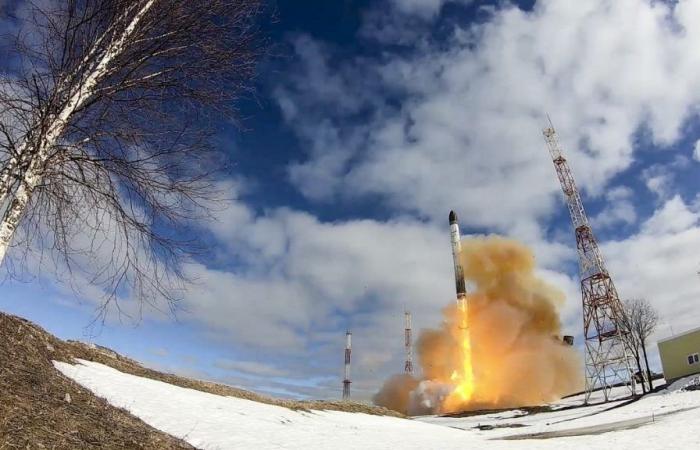Satellite images from last month appear to show a failed test launch of the RS-28 Sarmat missile, raising concerns about Russia’s nuclear arsenal.
ADVERTISEMENT
Satellite images taken in late September have led weapons experts to believe that Russia attempted to test its latest intercontinental ballistic missile, the RS-28 Sarmat, but failed. a catastrophic failure.
This 35-meter-long missile, capable of carrying nuclear warheads, has been called “Satan II” and “the world’s deadliest weapon” by various Russian and foreign media outlets, and is raising concerns due to its capabilities. presumed destructive.
Recent images appear to show a large crater at a launch site in Plesetsk, northern Russia. The discovery was first published on social media platform X on September 21 by an open source analyst under the pseudonym “MeNMyRC.”
“As can be seen, the test of the RS-28 Sarmat was a complete failure,” MeNMyRC wrote.
“The missile exploded in the silo, leaving a massive crater and destroying the test site.”
MeNMyRC also speculated that the missile may have exploded during the liquid fueling process and not at the time of launch.
This could explain the apparent absence of aircraft responsible for supervising the test launches. If experts are correct, this would be the fourth known failure of the RS-28. The only confirmed successful test of the weapon was in April 2022.
Political importance for Putin
Matt Korda, research associate at the Stockholm International Peace Research Institute (SIPRI), said at Euronews Next that the RS-28 is supposed to functionally replace the RS-20V Voyevoda, a missile created more than 30 years ago.
“Russia has long planned to replace each of its Cold War-era delivery systems with newer versions, and the RS-20V Voyevoda is the last of these types of ICBMs remaining in its arsenal,” Korda said. .
“As a result, the introduction of Sarmat will be politically significant for President Putin, as it embodies Russia’s completion of this long-awaited transition.”
The RS-28 was first revealed in 2014 at a press conference in Moscow.
At the time, Russian officials said the missile would be completed in 2020. Production was subsequently delayed several times due to manufacturing, production and testing issues.
Mr. Korda said that to date, the RS-28 has still not entered service.
“Not only was the missile’s mass production delayed, but its test cycle was marred by a series of postponements and failures,” Korda said.
What are the capabilities of RS-28?
Since its presentation, Russian media have reported that the RS-28 can carry up to 16 independently targeted nuclear warheads. However, Korda said the number was likely much lower, “perhaps as many as 10 warheads.”
The missile also has a range of at least 18,000 km and weighs more than 208 tonnes, according to the Russian military.
In October 2023, Russian President Vladimir Putin declared that the RS-28 was ready for deployment, in a speech translated by the Kremlin. “Overall, the Sarmat, the super-heavy missile, is also ready,” Putin said.
“Now we just need to complete all the administrative and bureaucratic procedures to be able to move into mass production and deploy it in combat standby mode. We will do it soon.”
In the same speech, Mr. Putin highlighted one of the goals of RS-28, which is to deter nuclear and military escalation by the United States.
He noted in particular that Russia had signed and ratified the Comprehensive Nuclear Test Ban Treaty, while the United States had only signed it.
The proposed treaty would ban all nuclear explosions, whether for military or peaceful purposes. To enter into force, it must be ratified before the Secretary-General of the United Nations by 44 designated “nuclear-capable states”.
In November 2023, Putin withdrew Russia’s ratification with the express purpose of reflecting the United States’ position. With several nuclear-capable countries still refusing to sign or ratify the treaty, weapons testing continued around the world.
According to Korda, the production of new missiles such as the Sarmat RS-28 is part of a modernization process to which “all nuclear-weapon states” are subject.
It is unclear what the status of the weapon is after its fourth alleged failure. Mr. Putin and Russian media have claimed the RS-28 was combat-ready for years, but images of the crater in September cast doubt on those claims for many experts.
Mr Korda said that despite difficulties encountered during testing, Russia would continue work on the RS-28.
“It is clear that Russia is continuing construction to facilitate deployment of the missile – satellite images indicate that construction is well underway at the 1st Regiment of the 62nd Missile Division in southern Siberia, and will begin soon on other deployment sites planned,” he explains.






